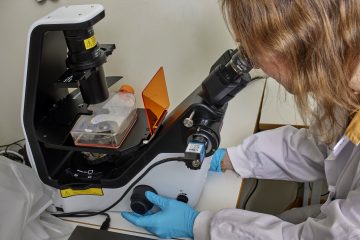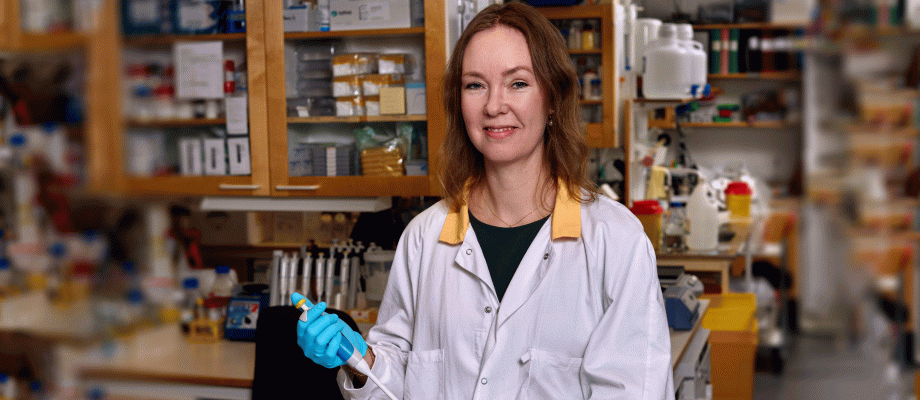GRANT. Helena Carén studies the mechanisms that govern the formation of our cells and the growth of brain tumors, and her research has already contributed to a new method for diagnosing brain tumors in children. 3.8 million SEK from the Lundberg Research Foundation is allocated to an advanced microscope that significantly accelerates the pace of work.

Every year, over 1,300 adults and nearly a hundred children in Sweden are diagnosed with brain tumors. Among children, brain tumors constitute a third of all cancers. For the most aggressive forms of brain tumors, there is currently no cure.
Helena Carén, a professor at the Institute of Biomedicine at the University of Gothenburg, studies DNA methylation, which is an epigenetic mechanism that tells the cell what type of cell it should become.
“All cells in the body have the same DNA, yet we have very many different cells and cell types in different parts of the body. This is because different parts of the genome are active in the formation of different cells. In cancer, the regulation of this process has often gone awry”, she explains.
Difference between children and adults
About half of all adults who are affected by brain tumors get the aggressive tumor glioblastoma, with a median survival of less than a year. Children mostly get low-grade tumors, but they can also be affected by malignant brain tumors, usually of the medulloblastoma type. It usually arises in the cerebellum and is treated with surgery, chemotherapy, and radiotherapy. Since children’s brains are still developing, they often suffer from treatment-related damage, resulting in lifelong neurological side effects.
Care and research differentiate between brain tumors in children and adults. It hasn’t always been this way. In the WHO classification of tumors of the central nervous system (the brain and spinal cord), the division between children and adults was only made in 2021. Thus, it was clarified that children and adults should be treated differently.
Milder side effects

Brain tumors occur in many different types, and several of them are difficult to diagnose. The information researchers obtain by studying DNA methylation can be used to identify the tumor’s cell of origin, something that in turn can be used for diagnosis. Research on DNA methylation has already made a difference in the form of the development of a new diagnostic method now used at Sahlgrenska University Hospital.
“If you don’t know what diagnosis it is, you don’t know how to treat the patient in the best way. We have worked extensively with DNA methylation profiling in order to group and diagnose tumors. Methylation profiling can, for example, identify subgroups of medulloblastoma, groups that also correlate with how well patients respond to treatment. Patients with tumors in one of these groups are doing very well, and they now receive gentler treatment, resulting in milder side effects”, says Helena Carén.
WHO defines 100 groups of brain tumors, but the work with DNA methylation profiling has led researchers to see that there are even more.
“This area is still under development. The more samples analyzed, the more groups we see.”
Critical genes

Helena Carén also works to increase understanding of why cells start to grow uncontrollably and form brain tumors and what drives the different types of tumors. She and her colleagues have access to tumor tissue from patients operated on at Sahlgrenska University Hospital. The cells in the tissue are cultured and studied in the laboratory. There, researchers can also test how tumor cells react to different treatments. In some studies, they work with CRISPR-Cas9, the tool whose discoverers were awarded the Nobel Prize in 2020.
“With the help of CRISPR-Cas9, we try to find out which genes are important for tumor cells to survive. If we find them, we can design treatments that target those specific genes.”
Long-awaited microscope
The research conducted by Helena Carén and her colleagues requires advanced technical equipment. Two years ago, an advanced microscope in their laboratory broke down. It was too old to be repaired and has not been replaced. The absence of this equipment has since limited research efforts. A grant of 3.8 million SEK from the Lundberg Research Foundation now makes it possible to purchase a new so-called HTS microscope (high-throughput screening).
“In an HTS microscope, we can analyze up to 384 samples simultaneously and obtain a lot of information. For example, we can look at the presence of certain proteins, analyze the size and shape of the cells, or expose them to different stimuli and see what happens while simultaneously documenting it. In a regular microscope, we handle one sample at a time, which becomes unreasonable in this type of study. We have been forced to pause the tests. Now we look forward to being able to resume them.”
BY: THE LUNDBERG RESEARCH FOUNDATION
PHOTO: BO HÅKANSSON












Leave a Comment